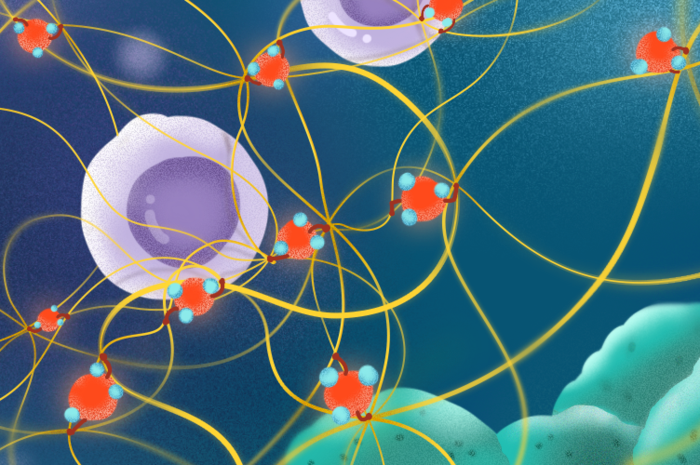According to a research article published recently in eLife, researchers have discovered a mechanism that highlights how fine air pollution particles may lead to lung cancer.
 Inhaled fine particulate matter (shown here in red) pulls strings of collagen to disturb the immune defense in mice with lung cancer cells. This activity delays the movement of cytotoxic T-cells (purple) as they migrate towards the cancer cells (green) to destroy them. Image credit: Wang et al. (CC BY 4.0).
Inhaled fine particulate matter (shown here in red) pulls strings of collagen to disturb the immune defense in mice with lung cancer cells. This activity delays the movement of cytotoxic T-cells (purple) as they migrate towards the cancer cells (green) to destroy them. Image credit: Wang et al. (CC BY 4.0).
The findings could bring about new methods for treating or preventing the early variations in the lungs that result in the disease.
Minute, inhalable fine particulate matter (FPM) detected in air pollutants has been documented as a Group 1 carcinogen and a considerable hazard to global health. Nevertheless, the cancer-causing mechanism behind FPM is still vague.
Despite its potential to cause mutations, recent research suggests that FPM does not directly promote – and may even inhibit— the growth of lung cancer cells. This suggests that FPM might lead to cancer through indirect means that support tumour growth. For example, some studies suggest FPM can prevent immune cells from moving to where they are needed.
Zhenzhen Wang, Study First Author and Associate Researcher, Nanjing University
Zhenzhen Wang conducted the study between laboratories at Nanjing University and the University of Macau where she was financially supported by a University of Macau Fellowship.
To investigate this possibility, Wang and colleagues gathered FPM from seven areas in China and examined its influences on the core immune cells that guard against the growth of tumors — known as cytotoxic T-cells (CTLs). In mice induced with lung cancer cells that were not subjected to FPM, CTLs were employed in the lung to kill the cancer cells.
However, in the mice whose lungs were subjected to FPM, the penetration of CTLs was slow — potentially permitting the cancer cells to grow in the lung tissue.
To examine why the CTLs did not penetrate the lung as rapidly in the FPM-exposed lungs, the researchers analyzed the CTLs as well as the lung tissue structure themselves. They discovered that CTLs subjected to FPM still kept their migratory ability, but that the lung tissue structure and the spaces that immune cells travel between were greatly compressed due to FPM exposure.
Also, it was noted that collagen was at much higher levels. Collagen is a protein that offers biomechanical support for tissues and cells. When the researchers examined the movement of CTLs in the animal with lung tissue subjected to FPM, CTLs found it hard to move, while those in the untreated tissue could move easily.
Additional examination of the tissue revealed that the structural variations were caused by surges in a collagen subtype known as collagen IV, but the researchers were still unaware of how FPM prompted this.
They discovered the answer when they examined in depth the structural disparities in collagen IV and the enzyme accountable for creating them — known as peroxidasin. This enzyme triggers a particular type of cross-linking that exposure to FPM was established to cause and aggravate in the lung tissue.
The most surprising find was the mechanism by which this process occurred. The peroxidasin enzyme stuck to the FPM in the lung, which increased its activity. Taken together, this means that wherever FPM lands in the lung, increased peroxidasin activity leads to structural changes in the lung tissue that can keep immune cells out and away from growing tumour cells.
Zhenzhen Wang, Study First Author and Associate Researcher, Nanjing University
“Our study reveals a completely new mechanism by which inhaled fine particles promote lung tumour development,” concludes senior author Lei Dong, Professor at the School of Life Sciences, Nanjing University.
We provide direct evidence that proteins that stick to fine particulate matter can cause a significant and adverse effect, giving rise to pathogenic activity. Our discovery that peroxidasin is the mediator of this effect in lung tissue identifies it as a specific and unexpected target for preventing lung disease caused by air pollution.
Lei Dong, Senior Author and Professor at the School of Life Sciences, Nanjing University
Journal Reference:
Wang, Z., et al. (2022) Air pollution particles hijack peroxidasin to disrupt immunosurveillance and promote lung cancer. Cancer Biology. doi.org/10.7554/eLife.75345.
Source: https://elifesciences.org